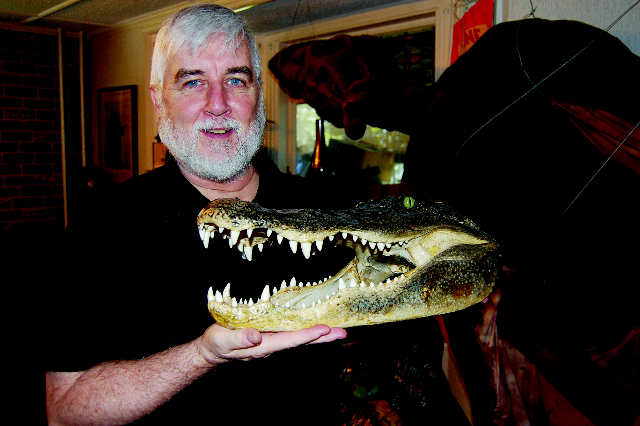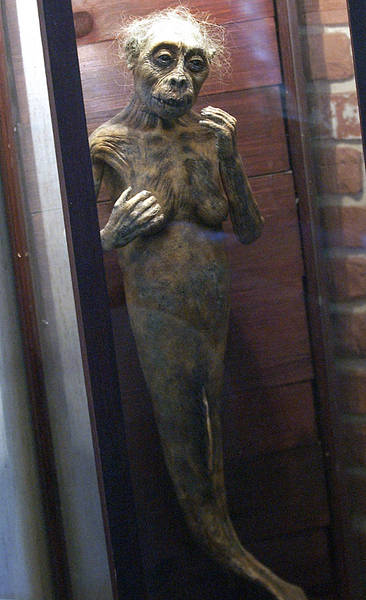
July 1, 2009
David Carkhuff, the news reporter of the new Portland Daily Sun, in conjunction with my appearance at the Ft. Knox talk on July 4th, interviewed me for a long article. The piece, entitled “Bigfoot and sea serpents and a search for the hidden: Portland’s ‘hidden animal’ researcher also takes an interest in report of Maine mountain lion,” appeared today. Excerpts are below, as well as the link to the online complete article.
The print edition has a different headline, btw: “Bigfoot and sea serpents and lions, oh my! Portland’s ‘hidden animal’ researcher also takes an interest in report of Maine mountain lion.”

Also, the print version has one color image of the Bigfoot and me on their cover (not available online), and two black & white images of the three color ones shown here. All are David Carkhuff photos.

Loren Coleman with a Bigfoot figurine. (David Carkhuff Photo.)
Bigfoot insists on eluding the public; stories of sea serpents off the Maine coast remain unconfirmed.
Yet, ask Portland’s premier researcher of hidden animals, Loren Coleman, and he will tell you it’s an exciting time to be a cryptozoologist.
One reason? A mother and her two sons recently reported seeing a mountain lion near Winslow.
Hmm, a mountain lion. Not Bigfoot? Not a lake monster?
Admittedly, mountain lions are rather mundane when you’re talking about cryptozoology. The research of “hidden animals,” Coleman’s field of study, prompted him to travel to the scene of a recent sighting of the Lake Champlain monster (the camera-phone footage taken by a lake visitor certainly looks like a Loch Ness monster knockoff; it has a long neck topped by a knoblike head). Coleman has probed similar sightings such as that of Cassie, the legendary Casco Bay sea monster.
At 1 p.m. Saturday [July 4, 2009], Coleman will discuss “Cryptozoology, the Study of Unknown and Undiscovered Animals” at the 2009 Fort Knox Paranormal and Psychic Faire near Prospect.
Coleman understands that a mountain lion report, even when state wildlife officials say there is no evidence of an established mountain lion population in Maine, won’t stoke interest among his readers and viewers quite like the newest Sea Serpent sighting or Bigfoot report.
When a television show like “MonsterQuest” seeks out Coleman as an expert guest, it’s to discuss the possible existence of Sasquatch, swamp apes or maybe even the giant squid. And when Coleman appears Saturday as a guest speaker at the paranormal fair at Maine’s Fort Knox, he knows questions will tend to focus on the more spectacular, the mysterious, the bizarre.
Coleman takes it all in stride. He has a giant, stuffed Bigfoot in his home and his walls are covered with monster memorabilia. After 50 years of researching hidden and as-yet undiscovered animals, Coleman maintains a sense of humor. But he also takes cryptozoology, his adopted field, quite seriously.
Yes, mountain lion are fair game for his field of inquiry, he insists. The recent reported sighting in Maine, he says, falls right in line with his expertise.
“In terms of cryptozoology, that’s a cryptozoology report because as long as they officially don’t exist, cryptozoologists are interested in getting sightings like that,” he said.
And don’t forget that in Maine, Bigfoot takes a back seat to big cats.
Black panthers in Maine?
Expect the subject of black panthers to come up at the Fort Knox fair.
“Every time I’ve done the talk, people come up to me and tell me about their cat sightings,” Coleman said. “Even though they’re the Bigfoot of the feline world, most people think they’re so mundane, but they really are so extraordinary because we aren’t supposed to have black panthers and mountain lions in Maine. We may be coming into a hot period of reports for mystery cats in Maine.”
Mostly, the reports surface in rural, less populated areas.
“I hear reports up and down the coast of Maine, more often from Waldo County … about black panther reports,” Coleman said. “There are not supposed to be any black panthers in Maine, yet Waldo County has the highest concentration of black panther cases on the East Coast.”
On [the] blog, cryptomundo.com, Coleman posted several threads about reported panther sightings in Maine.
“People are seeing large cats this spring in the Northeast, and getting serious about finding proof,” he wrote on June 1. He recounted the Winslow incident involving the mountain lion.
A year ago, on July 1, 2008, a restaurant owner in Island Falls in northeastern Maine reported that he and his wife saw a panther cross the road in front of them. Coleman documented his investigation into this sighting.
A year prior to that, Coleman documented his investigation of a series of Maine sheep killings and speculated that a black panther might be the culprit.
Coleman concluded on his blog, “Needless to say, a find of a dead black puma, i.e. mountain lion, or a classic black panther, i.e. melanistic leopard (that is not a former captive) verified as being a native of North America would be a remarkable cryptozoological discovery. …”
State wildlife officials in the Winslow case speculated that the mountain lion spotted by the mother and her sons had been released into the wild and wasn’t indigenous. Exotic pets released in the United States, especially alligators and pythons, can account for some sightings, Coleman conceded, but usually cats and other domestic animals, even if exotic, will return to populated areas and not try to survive in the woods, he said.
Of course, with any search for a missing animal, there are bound to be hoaxes.
In 1999, while writing his book, Cryptozoology A to Z, Coleman investigated reports from a college student about an Ozark howler, “a black panther-type creature.” The student concocted an elaborate Internet hoax, even creating mock websites to corroborate his find, but through careful review, Coleman said he debunked the student’s claims.
“People do that occasionally, and I’m usually quite cautious and careful,” he said.
What about Bigfoot in Maine?
For more from the article on Bigfoot, see here.
A background in science, searching
Hoaxers, beware. Coleman has learned to sniff out a fake.
“I have a background in anthropology, zoology and psychiatric social work, so it’s pretty hard to fool me, and I’ve also been doing this for 50 years, so I’ve seen everything by now,” Coleman said.
This is his third year at the Fort Knox paranormal fair. Coleman enjoys the interaction but treats the subject matter with gravity.
“These conferences I don’t take lightheartedly. I know the people there are serious about their crafts,” he said.
“I certainly take cryptozoology very seriously, and I always consider whether or not I want to appear at a fair or a conference that’s about the paranormal because most cryptozoologists like myself really see cryptozoology as the study of hidden or unknown, yet to be identified animals, it’s not mythical creatures,” Coleman said.
The Fort Knox fair, however, is a well respected event, he said, and it’s also a benefit to raise money for the historic site, “so I can get behind that cause.”
Coleman said on Saturday he will give an introduction and overview about cryptozoology and its discoveries and then discuss current events.
“Cryptozoology is a way that zoology understands and discovers new animals by getting information from local people, from natives, from folklores and traditions to really build up a case to see if there’s any physical evidence for those actual animals existing,” he explained.
This research approach paved the way for discovery of giant pandas, mountain gorillas and Coelacanths, a new species of fish related to lungfishes and tetrapods found in eastern Africa, Coleman said. He recently posted on his blog about a new species of bat found in the Comoros island archipelago.
Coleman grew up in Decatur, Ill., where there weren’t many woods, mostly cornfields, so exploration was limited. By 1980, he and his wife [at the time] lived in Cambridge but enjoyed visiting their cabin in Rangeley. A fan of Maine, Coleman moved to Portland in 1983. The city has been his home ever since, and a perfect launching pad for investigating sightings.
“Because I’m a generalist, because I’m a cryptozoologist and not just a Bigfooter, I hear all of the reports….”
More on the quest for Maine’s coastal and related mysteries, see here.
Enjoying the hunt
A half century into his career, Coleman continues to glean stories and anecdotes….
“I have a worldwide base of readers in my Cryptomundo blog that’s been around for five years,” he said.
Appearances on the History channel show, “MonsterQuest,” have raised his visibility as well. Coleman is unapologetic about going on TV to promote cryptozoology.
“If we look at the history of cryptozoology and the discovery of animals from about the beginning of the 20th century through about 1950, all of the funding was from museums and zoos,” he explained. “After the 1960s, certainly in the ’80s, ’90s and in this century, almost 90 percent of the funding has been from film companies, documentary film companies, from television series, who are sending people into the woods, sending people on expeditions to Mongolia or Nepal or to Australia from sites in western Europe and America. As a funding source, we have to be realistic.”
While active on the Internet, Coleman said TV and newspapers remain important sources of funding for those in his field.
“People can make fun of television, they can make fun of newspapers all they want, in saying they’re dying arts compared to the Internet, but it’s from those sources, the print media and the visual media, that we’re getting our funding to make this profession really work,” Coleman said.
Lectures, like his presentation on Saturday, often result in fresh fodder for inquiry.
“It’s at talks like this that people feel comfortable to come up and they give me new material sometimes,” Coleman noted.
Later, over Labor Day weekend, Coleman will give a talk at the Waldo Theater [located in Lincoln County in Waldoboro]; and that same weekend, he will present a commentary on sea serpents during a whale watch excursion out of Belfast.
Clearly life is good for Coleman as he enjoys his profession.
“I’m talking about cryptozoology, I’m writing about it, I’m lecturing about it and I’m going on expeditions,” he said.
And while he may not run into Bigfoot any time soon, Coleman said he enjoys the human interaction.
“You never can tell who you’ll meet,” he said.

Photo credit: Amber Waterman/Sun Journal.
About Loren Coleman
Loren Coleman is one of the world’s leading cryptozoologists, some say “the” leading living cryptozoologist. Certainly, he is acknowledged as the current living American researcher and writer who has most popularized cryptozoology in the late 20th and early 21st centuries.
Starting his fieldwork and investigations in 1960, after traveling and trekking extensively in pursuit of cryptozoological mysteries, Coleman began writing to share his experiences in 1969. An honorary member of Ivan T. Sanderson’s Society for the Investigation of the Unexplained in the 1970s, Coleman has been bestowed with similar honorary memberships of the North Idaho College Cryptozoology Club in 1983, and in subsequent years, that of the British Columbia Scientific Cryptozoology Club, CryptoSafari International, and other international organizations. He was also a Life Member and Benefactor of the International Society of Cryptozoology (now-defunct).
Loren Coleman’s daily blog, as a member of the Cryptomundo Team, served as an ongoing avenue of communication for the ever-growing body of cryptozoo news from 2005 through 2013. He returned as an infrequent contributor beginning Halloween week of 2015.
Coleman is the founder in 2003, and current director of the International Cryptozoology Museum in Portland, Maine.
Filed under Breaking News, Conferences, Cryptotourism, CryptoZoo News, Cryptozoologists, Cryptozoology, Cryptozoology Conferences, Media Appearances, Men in Cryptozoology, Pop Culture, Public Forum, Television